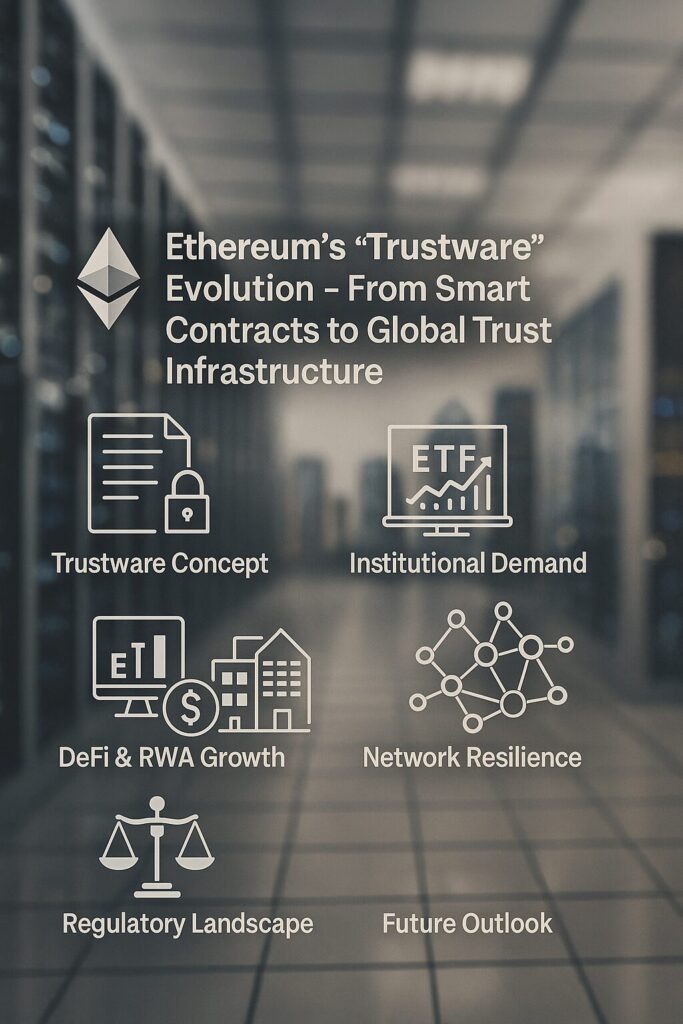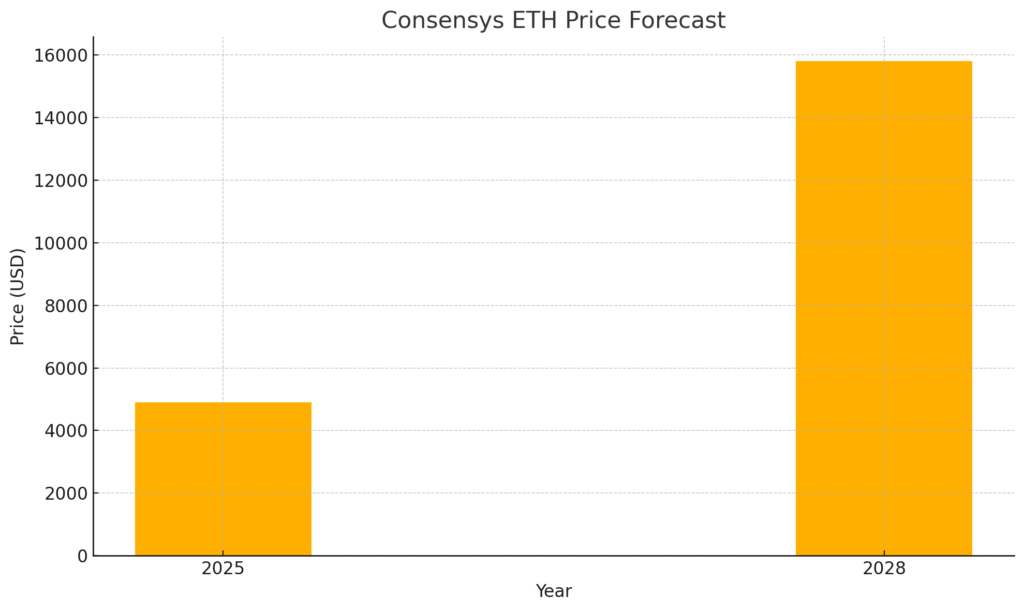
Main Points:
- Trustware Concept: Ethereum’s transition from a smart contract platform to foundational “Trustware” for the global economy.
- Cost-to-Corrupt Model: How network security underpins ETH’s value and Consensys’s price forecasts.
- Institutional Demand: Surge in spot ETH ETF inflows and institutional holdings driving network utility.
- DeFi & RWA Growth: Stablecoins, tokenized real-world assets, and DeFi TVL as early trustware indicators.
- Network Resilience: Ten years, 21 upgrades, 1.056 million validators—Ethereum’s robustness and scalability.
- Regulatory Landscape: ETF approval delays, in-kind creation debate, and U.S. regulatory trends.
- Future Outlook: Algorithmic finance era, tokenized assets trading at scale, and long-term ETH demand drivers.
Trustware: Ethereum’s New Identity
Ethereum celebrated its 10th anniversary as it redefines itself beyond a programmable ledger into “Trustware”—an on-chain infrastructure providing verifiable, code-enforced trust globally. Traditional trust services—legal systems, audits, notarization—cost over $9.3 trillion annually. Trustware promises near-instant, transparent trust across borders, replacing intermediaries with mathematical certainty, unlocking new markets and business models.
According to Jason Linahan, Chief Strategy Officer at Consensys, Trustware encapsulates the cumulative economic value embedded in Ethereum’s ledger, built block by block by the Foundation, Consensys, and a global developer community. As enterprises and financial institutions recognize these efficiencies, Ethereum’s network utility—and demand for ETH—will escalate.
Cost-to-Corrupt: The Security-Value Framework
Subtitle: Modeling ETH’s Value Floor
The “Cost-to-Corrupt” model links ETH’s market capitalization to the cost an attacker must incur to compromise network security. As on-chain economic activity grows, so does the deterrent against attacks: more at stake means higher security incentives.
- 2025 Forecast: $4,900 per ETH by end-2025
- 2028 Forecast: $15,800 per ETH under conservative assumptions of
- $1 trillion in stablecoins,
- $500 billion in tokenized real-world assets (RWA),
- $300 billion in DeFi Total Value Locked (TVL).
These figures underscore ETH’s asymmetric upside if Ethereum continues to capture trustware use cases. <!– Chart: Consensys ETH Price Forecast –>

Consensys ETH Price Forecast
(as generated above)
Institutional Demand and ETF Inflows
Subtitle: Spot ETH ETFs Break Records
Institutional adoption is tangible. Spot Ethereum ETFs are seeing record inflows:
- On July 16 2025, spot ETH ETFs posted a $726.74 million single-day net inflow—their highest ever.
- BlackRock’s iShares Ethereum Trust (ETHA) now holds over 2 million ETH (≈1.65% of circulating supply), with AUM exceeding $5.5 billion.
- Cumulative net inflows for spot ETH ETFs have surpassed $6.48 billion so far in 2025.
These flows reflect growing confidence in regulated Ethereum exposure, fueling on-chain liquidity and network effects.
DeFi, Stablecoins & RWA: Early Trustware Indicators
Subtitle: The Building Blocks of Trustware
Consensys highlights early signs of Trustware adoption:
- Stablecoins: Anchoring $X trillion of on-chain liquidity, stablecoins facilitate cross-border payments and DeFi operations.
- Tokenized RWA: Real-world assets—bonds, real estate—worth hundreds of billions are moving on-chain, promising greater transparency and fractional ownership.
- DeFi TVL: With TVL around $300 billion, DeFi protocols demonstrate programmable financial services: lending, derivatives, and algorithmic markets.
As these sectors expand, they deepen Ethereum’s role as foundational infrastructure, raising ETH utility and security stakes.
A Decade of Resilience and Scalability
Subtitle: Network Evolution Through Upgrades
Over ten years, Ethereum has executed 21 major network upgrades, pioneering innovations from smart contracts and NFTs to rollups and Proof-of-Stake (PoS). Key metrics:
- Validators: 1,056,000 across 84 countries, securing institutional-grade capital flows.
- Upgrades: Transition to PoS (“The Merge”), sharding research, Layer 2 rollups, and EIP-1559 fee burn—each enhancing security, scalability, and fee efficiency.
Institutional investors, unlike speculators, demand robust, battle-tested infrastructures. Ethereum’s track record positions it as the default platform for billion-dollar capital deployment.
Regulatory Landscape: ETF Mechanics & Delays
Subtitle: Navigating U.S. Crypto Policy
U.S. regulators continue to shape crypto’s bridge to traditional finance:
- The SEC has granted spot ETH ETFs but is delaying decisions on in-kind creation/redemption mechanics until September 2025.
- Commissioner Hester Peirce hints in-kind settlements—transferring actual ETH rather than cash—are “definitely coming,” which could reduce ETF slippage and costs.
Regulatory clarity on in-kind processes and staking allowances will be pivotal for ETF efficiency and returns (currently limited to prevent PoS staking rewards).
Emerging Trends & Recent Developments
Subtitle: Beyond the Consensys Report
- Layer 2 Surge: Rollup transactions on networks like Arbitrum and Optimism now account for over 50% of total Ethereum throughput.
- Institutional Partnerships: Major asset managers (Fidelity, Invesco/Galaxy) expanding spot ETH ETF product lines, enhancing competition and liquidity.
- Regtech Integrations: On-chain analytics firms (Chainalysis, Elliptic) partnering with banks to monitor compliance, signaling trustware’s integration into legacy systems.
These trends reinforce Ethereum’s central role in evolving digital finance.
Conclusion
Ethereum’s journey from an experimental smart contract platform to a foundational “Trustware” layer marks a paradigm shift in global trust infrastructure. The Cost-to-Corrupt framework and Consensys’s bullish ETH price forecasts illustrate how network security underpins value. Record ETF inflows, tokenized assets, and robust validator participation demonstrate early adoption of Trustware principles. While regulatory hurdles remain—particularly around ETF mechanics and staking—ongoing institutional interest and protocol upgrades poise Ethereum for unprecedented growth. As we enter an era of algorithmic finance, tokenized real-world assets and stablecoins will trade at machine speeds, cementing Ethereum as the bedrock of the new economic order.

